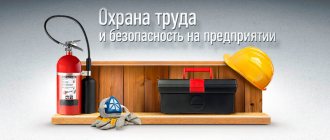Classification of harmful and dangerous production factors
There are basic approaches to the classification of hazardous and harmful production factors.
According to the effect on the body of a working person:
- harmful production factors are divided into: factors leading to chronic diseases, including aggravating existing diseases, due to long-term, relatively low-intensity exposure;
- on factors leading to acute diseases (poisoning, injuries) or injuries due to short-term (single and/or almost instantaneous) relatively high-intensity exposure.
- on factors leading to fatal injuries (fatal outcome, death);
Dangerous and harmful production factors are divided into:
- by the nature of its origin on:
- factors generated by the physical properties and characteristics of the state of material objects of the production environment;
- factors generated by the chemical and physicochemical properties of substances and materials used or located in the work area;
- factors generated by the biological properties of microorganisms located in biological objects and (or) polluting material objects of the industrial environment;
- factors generated by behavioral reactions and defense mechanisms of living beings (bites, stings, release of poisonous or other protective substances, etc.);
- factors generated by socio-economic and organizational-managerial conditions of work (poor organization of work, low safety culture, etc.);
- factors generated by the mental and physiological properties and characteristics of the human body and personality of the worker (poor health of the employee, the employee being in a state of alcohol, drug or toxic intoxication or abstinence, loss of concentration by employees, etc.).
- by the nature of their changes over time:
- permanent, including quasi-permanent;
- variables, including periodic ones;
- impulse, including regular and random.
- by the nature of their action over time:
- permanent;
- periodically operating, including intermittent;
- aperiodically acting, including stochastic ones.
- by the nature of their action in space:
- constantly localized at the source of their origin;
- localized in normal situations, but scattering (moving, spreading) in the space of the production environment in emergency situations;
- spreading (moving) along with air movement in the production environment;
- spreading (moving) through the production environment or other space in the form of material objects, including gas jets;
- propagating (penetrating) radiation and waves in the production environment.
- by the nature of their spatial distribution:
- spatially distributed (in the field of action of which there is a person, his workplace, etc.);
- suspended or dissolved in the air (or capable of becoming a gaseous or aerosol state) and being a component of it;
- dissolved in a liquid and being its component;
- forming locally limited solid macro-volume objects;
- contained in the local macro-volume objects that limit them.
- by the directness of its impact:
- those that directly affect the body of a person engaged in work;
- indirectly affecting the body of a person engaged in work through other factors generated by them and directly affecting the body of a person engaged in work.
- according to the nature of mutual action with multifactorial influence on the human body:
- to independently acting;
- cumulatively acting;
- synergistically acting;
- antagonistic.
- by the nature of their detection by the human body:
- to those detected organoleptically (for example, light/darkness, noise, vibration, smell, taste, heat/cold, heaviness, slipperiness, roughness, etc.);
- organoleptically undetectable (for example, gaseous substances without taste, color, odor; electrical potential, etc.).
- by source of origin:
- to natural (including climatic and weather conditions in the workplace);
- technical and technological;
- ergonomic (that is, related to the physiology of the human body).
- by the nature of their impact on the working person’s body:
- on factors whose impact is of a physical nature;
- factors whose influence is of a chemical nature;
- factors whose influence is biological in nature.
- by source of origin:
- to psychophysiological;
- organizational and managerial;
- personal-behavioral (that is, related to the worker himself);
- socioeconomic.
At many enterprises, the production cycle is inextricably linked with the impact of harmful substances on humans. Administration and management should make every effort to try to eliminate or reduce this impact.
Return to content
Classification by type of impact
If we classify the main hazardous and harmful production factors by type of impact, we get the following groups:
- physical;
- chemical;
- biological;
- psychophysiological.
But this classification is rather arbitrary, because the same factor, by the nature of its impact, sometimes belongs simultaneously to different groups. Thus, the work of slaughtering cattle can expose a person to all threatening factors at once. The classification is set out in GOST 12.0.003-74 SSBT and approved by Resolution of the State Committee of Standards of the Council of Ministers of the USSR dated November 18, 1974 No. 2551.
The general classification of dangerous and harmful production factors is as follows:
Each industry and type of work has its own adverse impacts, for example:
- for a pharmacy worker - an increased level of toxic products, poisonous and potent substances in the air, a high probability of contracting an infectious disease;
- for a concrete mixer - increased level of vibration and moving parts of mechanisms;
- dangerous and harmful factors for the driver - moving mechanisms, increased gas and dust levels in the air; high concentration of harmful fuel vapors in the air, insufficient illumination of the work area;
- the operator of a cement or other bulk cargo loader experiences increased physical stress, etc.
But for all of these professions and jobs there is a common dangerous factor - electric shock.
Identification of harmful and dangerous production factors
In accordance with Federal Law No. 426-FZ dated December 28, 2013 (as amended on December 27, 2018) “On special assessment of working conditions”, Article 10, paragraph 1.
The identification of potentially harmful and (or) dangerous production factors means the comparison and establishment of a coincidence of the factors of the production environment and labor process existing in the workplace with the factors of the production environment and the labor process provided for by the classifier of harmful and (or) dangerous production factors...
Clause 3. When identifying potentially harmful and (or) dangerous production factors at workplaces, the following must be taken into account:
- production equipment, materials and raw materials used by workers and which are sources of harmful and (or) hazardous production factors that are identified and, in the presence of which, in cases established by the legislation of the Russian Federation, mandatory preliminary (upon entry to work) and periodic (during employment) activities) medical examinations of employees;
- results of studies (tests) and measurements of harmful and (or) hazardous production factors previously conducted at these workplaces;
- cases of industrial injuries and (or) establishment of an occupational disease that arose in connection with the exposure of an employee to harmful and (or) dangerous production factors at his workplace;
- proposals from workers to identify potentially harmful and (or) dangerous production factors at their workplaces.
Clause 4. If harmful and (or) dangerous production factors at the workplace are not identified, the working conditions at this workplace are considered acceptable by the commission, and research (testing) and measurements of harmful and (or) dangerous production factors are not carried out.
Clause 5. If harmful and (or) dangerous production factors in the workplace are identified, the commission decides to conduct research (tests) and measurements of these harmful and (or) dangerous production factors...
Clause 6. Identification of potentially harmful and (or) dangerous production factors is not carried out in relation to:
- workers’ jobs, professions, positions, specialties of which are included in the “lists” of relevant works, industries, professions, positions, specialties and institutions (organizations), taking into account which the early assignment of an old-age insurance pension is carried out;
- workplaces in connection with work in which employees, in accordance with legislative and other regulatory legal acts, are provided with guarantees and compensation for work under harmful and (or) dangerous working conditions;
- workplaces in which, based on the results of previously conducted certification of workplaces for working conditions or a special assessment of working conditions, harmful and (or) dangerous working conditions were established.
The levels of hazardous and harmful production factors are determined by instrumental measurements.
Depending on the ratio of levels of dangerous and harmful factors and maximum permissible levels, working conditions according to the degree of harmfulness and danger are divided into four classes:
Class 1 – optimal working conditions;
Class 2 – acceptable working conditions that can cause functional deviations, but after regulated rest the human body returns to normal;
Class 3 – hazardous working conditions, characterized by the presence of harmful production factors that exceed hygienic standards. They have an adverse effect on the worker and can negatively affect the offspring.
Working conditions of class 3 hazardousness are divided into four degrees:
3.1. – working conditions characterized by such deviations from hygienic standards that cause reversible functional changes and cause the risk of developing the disease;
3.2. – working conditions with such levels of dangerous and harmful factors that can cause persistent functional disorders, leading in most cases to an increase in morbidity with temporary disability, an increase in the frequency of general morbidity, and the appearance of initial signs of occupational pathology;
3.3. – working conditions characterized by such levels of harmful factors that lead to the development of occupational pathology in mild forms during the period of work, the growth of chronic general somatic pathology, including increased levels of morbidity with temporary disability;
3.4. – working conditions under which pronounced forms of occupational diseases can arise, there is a significant increase in chronic pathology and high levels of morbidity with temporary disability.
Class 4 – hazardous (extreme) working conditions, characterized by such levels of production factors, the impact of which during a work shift (or part of it) creates a threat to life, a high risk of severe forms of acute occupational injuries.
Return to content
Benefits for an employee in hazardous work
Federal legislation provides benefits for all professions that have unfavorable working conditions.
Employees of such enterprises are assigned the following benefits:
- Increased wages. The increase in official salary is made by at least four percent;
- Additional vacation. This category of workers can take out additional leave every year, which will be paid by the employer. The vacation period must be at least seven days;
- Opportunity to retire earlier. Men can legally retire at fifty-five years of age, and women at forty-five, if they are included in the first list, and fifty years for women and fifty-five years for men, if they are included in the second list;
- The duration of the shift should be from six to eight working hours, and no more than thirty-six hours in seven days;
- Nutrition. Before starting work, the employer is obliged to provide workers with a hot breakfast, and after the shift - with milk or fermented milk products;
- Free medicines and personal protective equipment;
- As well as other preferential benefits provided in certain regions.
Influence of psychophysiological factors on occupational safety
The main indicators of a person’s work activity are considered to be his ability to work, i.e. the ability to perform formed, purposeful actions. From a physiological point of view, this is the ability of the human body to withstand a given physical and emotional stress during the work process.
Changes in physiological functions that cause a decrease in human performance during labor are called industrial fatigue. The psychological state of a person associated with fatigue is called fatigue. In the absence of overloads that cause fatigue, the body’s performance when stopping work or changing the type of activity is completely restored.
Intellectual load.
Mental work is considered easy, in which there is no need to make a decision. If the employee makes a decision within the framework of the instructions, then such working conditions are acceptable. Stressful working conditions include work that involves solving complex problems using multiple instructions.
In the process of production activity, a person performs tasks of varying degrees of complexity. Processing any information or performing a task without evaluating its results is less complex work, which allows it to be assessed as optimal. If, in addition to these actions, the need to verify the result obtained is added, then such working conditions are acceptable. The functions performed under time pressure and if responsibility for the final result is added, determine the work performed as intense.
Sensory loads
They are assessed by the duration of concentrated observation, the density of signals and messages, the number of production facilities being monitored, as well as the load on the visual and auditory analyzer. The duration of concentrated observation as a percentage classifies this indicator as follows:
The intensity of labor also depends on the number of simultaneously observed objects. In this case, objects mean a technological process, instrumentation, production product, etc. With an increase in the number of objects of simultaneous observation, labor intensity increases.
The load on the visual analyzer is determined by the size of the object in question and the observation time. The smaller the size of the object in question and the longer the observation time, the higher the load on the visual analyzer and the labor intensity increases accordingly.
Working with video display terminals for up to two hours per shift is considered optimal, up to three is acceptable.
Working at a computer or monitoring the process via a video terminal for more than the specified time is defined as stressful.
Emotional stress.
The degree of responsibility for the result of one’s own activities and the significance of an error indicates the extent to which an employee can influence the result of one’s own work at various levels of complexity of the activity performed. With increasing complexity, the degree of responsibility increases, since erroneous actions lead to additional efforts on the part of the employee or the whole team, which, accordingly, leads to an increase in emotional stress. If there is no risk to one’s own life in the process of performing one’s duties, the performer’s work is considered optimal, but if it is likely, then the working conditions are considered stressful. Working conditions are similarly assessed according to the degree of risk for the safety of other persons.
Return to content
Types of factors
Factors in the production process can be divided into 4 categories.
Physical
Various factors influence harmfulness.
These, in turn, include: illumination, temperature and humidity conditions, electromagnetic radiation, noise, background radiation, physical overload. When conducting a special assessment, measurements are taken with instruments that have been certified in the prescribed manner.
Experts working with these devices must also have the appropriate permit. Only if these two conditions are met are the results accepted as reliable. Standard indicators of the effect of substances on humans are easy to find in SanPiNs, state standards and other documents.
Chemical
During work, a person is directly affected by harmful chemicals, for example, fumes from welding or gas cutting of metal contractions release ozone, iron, manganese and welding aerosol. They are especially noticeable when working with chemical reagents.
To determine their level of exposure, measurements are taken and laboratory tests are performed. Maximum permissible concentrations are indicated in reference books, and measurements are carried out by an accredited laboratory.
Increased dust content in the air can also be attributed to a chemical harmful factor.
In this case, air measurements are also taken at a specific workplace.










